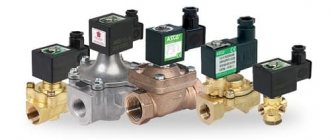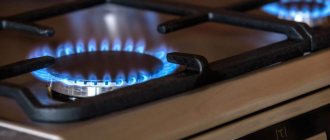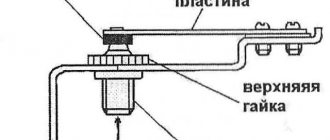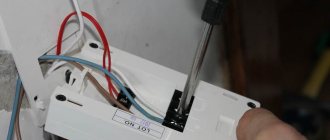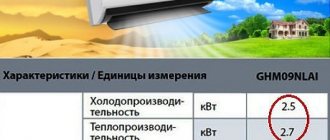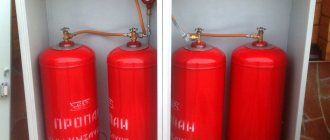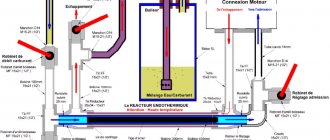Purpose and device
A gas solenoid valve is designed to control gas flows in pipes.
A gas valve of this type can be regulating or shut-off, and is controlled manually or using an automatic system. In design and purpose, this element resembles its standard counterpart, with the difference that the locking part in it is driven by an electromagnet, supplemented by a movable core. When voltage is applied to the coil, it begins to push or pull in the core, which is connected to the rod. This part is intended for use in industrial installations, domestic heating systems and in the water supply sector. The valve device has a standard design:
- housing with two pipes;
- chamber with saddle;
- the locking part is of a disc, petal or spherical type;
- return spring;
- rod for connection with the locking part and the core;
- solenoid.
The housing for installation is made of non-magnetic metal alloys or durable plastic. Its optimal tightness allows the valve to be used in a variety of environments. The process of controlling the part is carried out via wires that are connected to the electrical contacts of the sensor located on the outside of the housing.
The valve must meet the required level of resistance to noise, vibration and electromagnetic fields.
Gas detector and leak sensor without gas valve
Gas alarm, gas leak sensor is plugged into the electrical outlet.
The device beeps, the LED flashes, but the gas supply does not turn off. of gas alarms and gas leak sensors on sale , the design of which does not provide for connection and control of a gas shut-off valve. When triggered, such alarms emit light and sound signals and even send SMS messages to a smartphone, but do not shut off the gas supply.
Installation of such devices, without a gas shut-off valve, is simpler and less expensive. A home craftsman can install the alarm independently, without calling gas service specialists. But you should understand that the reliability of protecting your home and family members from fire, explosion or poisoning with such equipment will be much worse. In addition, the protection system will not meet the requirements of current regulations .
Often such devices are sold without the necessary documentation or they do not meet the requirements of the regulations. There are no metrological verification, certificates, the service life of devices and replacement of sensors is not indicated, the threshold for their operation is unknown. There are problems with warranty and service, replacement of sensors.
Watch a video about a household gas alarm from one of the Russian manufacturers:
Classification of gas valves
Design of a solenoid valve for gas
Solenoid valve for domestic gas is divided into categories depending on external features, operating environment, method of operation and installation, as well as a number of other nuances.
By type of execution
Taking into account the position of the main element and its diagram, the gas shut-off valve can be normally open or closed. In the first case, a passage for gas or liquid will be open in the element; when voltage is applied, it will automatically close; in the second case, this process occurs the other way around. In addition to such devices, there are their universal analogues, working in two directions at once.
By type of work environment
Taking this parameter into account, fittings of this type are produced specifically for operation in air, steam, water, fuel and lubricants or active media. Devices operating in radiation conditions are made of special resistant materials.
According to operating features
According to the characteristics of the external environment, the gas electrovalve is manufactured for operation under normal conditions, especially for rooms with high levels of humidity, operation at high and extremely low temperatures. The valves are also complemented with explosion protection provided by special parts and materials.
According to the operating principle
The operating principle of a magnetic valve depends on the voltage type of the coil, which can be AC or DC. Elements of the first type are used for high-pressure main pipelines, the second - for pipes with a small cross-section and low pressure.
From the number of saddle strokes
The functioning of the element is influenced by the number of strokes, depending on which it can be one-way, two-way or three-way, taking into account the number and type of valve nozzles. Depending on the design, they can be incoming or outgoing.
By type of control
The electric valve for domestic gas operates in two ways; according to the type of control, such fittings can be direct or indirect. Parts of the first type are designed for environments with a complete absence of pressure; their analogues of the second type are supplemented with a pilot element, which is activated automatically when there are differences in the medium at the inlet and outlet.
By type of functionality
The functionality of the valve depends on the material from which it is made. Most often, such elements are made from elastic polymers of various groups, which are made using special technology. Due to their high strength, they can withstand temperatures from -40 to +250 degrees.
Equipment setup
As an example, consider the configuration option for a popular gearbox from Tomasetto (Tomasetto AT-07 electronic). Adjustment of 2nd generation Lovato gearboxes and its full analogues, such as Atiker and Torelli, is performed in a similar manner.
In order to adjust second-generation gas equipment with your own hands, you need to warm up the engine to operating temperature on gasoline, switch to gas and turn off the engine. From now on, we will separate the tuning options for different types of engines.
Correct adjustment of 2nd generation HBO on a carburetor with your own hands
Using a flat-head screwdriver, tighten the screws of the gearbox and dispenser until they stop (without much effort), and then unscrew:
membrane sensitivity 2-3 turns; “greed screw” of the first chamber until fully open, the second by 1 turn. Start the engine on gas. Gradually tighten the sensitivity screw to find the moment the speed drops at a lean mixture
Attention! A drop may occur when the mixture is enriched. Therefore, if, when unscrewing the screw, the speed increases, and then falls again, it means that this is working on a rich mixture
Now, by screwing the screw back in clockwise, you need to set the peak of increased engine speed - this way the idle speed will be found (800-850 rpm). If higher, adjust the quantity screw on the carburetor itself to the desired readings. Use the accelerator to increase engine performance around 3000 rpm. Use the “greed screw” of the first chamber to set the moment when, when it is tightened, the drop begins, and when unscrewed, the speed increases. Release the accelerator and revoke the throttle; if the internal combustion engine develops low speed (there is a dip), unscrew the screw of the first chamber of the power register by 1/8. At the same time, adjust the sensitivity screw as indicated in point No. 2. Check by re-gasping again. The second chamber of the carburetor operates at increased engine speeds from 3000 rpm (depending on the engine brand). Therefore, the “greed screw” of the second camera must be set to approximately the same position as the first. Next, you need to carry out control tests on the move under different loads (lifts, sudden accelerations).
Setting up 2nd generation HBO on an injector
- Unscrew the screw of the power register and membrane by 2-3 turns, tighten it until it stops.
- Start the engine. Raise the engine speed to 3000-3500 rpm, by tightening and unscrewing the dispenser, find the peak of maximum engine speed. From this position, screw in the register screw 0.5 turns.
- Release the accelerator and revise the throttle. If the engine starts to choke, unscrew the metering bolt 1/8. And so on until finding the optimal speed set.
- Then, gradually tightening the membrane sensitivity screw, find the moment the speed drops, loosen the screw by 1/8.
5. Make further adjustments during sea trials. If the car does not develop enough power, slightly release the gas supply with the register screw.
Principle of operation
The operation of the device is based on the principle of electromagnetic instruction, when current flows through the coil, a magnetic field is formed inside it, affecting the core, depending on the position of which the gate element opens or closes. A valve for any gas pipe can have a different control voltage. Low level devices are low power, so they operate using low voltage semiconductor circuits. Such valves are used in systems with low pressure working media, on gas pipelines with a small diameter.
Drives operating on alternating current are considered more efficient, for this reason they can be installed on main pipelines with high pressure.
Malfunctions. What should you know?
It should be noted that situations often arise when the LPG filling valve device fails, and the reasons can be very different. For example, if you notice that it does not work as it should, and perhaps does not respond at all, then you should study all the reasons for what is happening. Here they are:
- More and more often we have to face such a problem as the accumulation of foreign elements - this is the most common reason. All this happens due to the fact that debris begins to accumulate on the surface of the core, and this leads to the fact that the LPG valve stops working properly.
- It is necessary to take into account: with long-term use of the valve, sediment begins to appear on it. This leads to the fact that the product stops working correctly. Thus, the petrol solenoid gas gas valve requires that all points of the operating instructions be strictly followed, and when problems arise, they are immediately resolved.
- Situations often arise when the product is in good working order, it functions and works without interruptions, but the system itself does not work. Thus, it is not possible to switch from gas to gasoline.
You may be interested in >> Filter for gas equipment 4th generation
If you encounter such a problem, then you need to carefully check the power supply to the coil of the product; there may be poor contact of the power wires or oxidation of the contacts has occurred.
Attention: You should listen to the opinion of experienced specialists, because in order to avoid such troubles, you need to carry out regular maintenance of the gas equipment, and accordingly, change the filter elements on time. In addition, you need to refuel exclusively with high-quality gas by visiting proven gas stations.
Scope of application
Household and industrial devices
The standard solenoid gas valve has a wide range of applications and can be used in all areas where there is a need to control remote flows of liquids and gases. This list includes heating systems, water treatment and water supply, irrigation and sewerage systems, household appliances, and pipeline transport. The device is rarely used for vehicles, but its relevance is increasing in other industries.
Functions of devices integrated into multivalves
- Protects the cylinder from gas leakage
When the cylinder is filled to 80% with liquefied gas, the filling valve shuts off the fuel supply. Complete filling of the actual volume of the cylinder is unacceptable according to safety requirements - under the influence of some external factors, for example, a sharp change in the temperature of the environment, the gas can expand sharply, which can be fraught with dangerous consequences when fully loaded (the container can even explode), that is, when the pressure reaches at 25 atmospheres (standard storage device)
- Adjusting the supply level to the gas main
There is a special anti-slam high-speed valve on the gas pipeline that regulates the rate of fuel supply into the gas pipeline. Additionally, it performs another safety function - it prevents potential leakage if deformation or breakage of the car line occurs.
- Safety valve
Emergency fire protection for a car that runs on gas consists of a separate element of the multi-valve: the fuse will release fuel through the ventilation unit outside the car if a sharp and strong increase in temperature (hence, excess pressure in the system) signals the outbreak of a fire in the immediate vicinity of the LPG .
The presence of a fuse automatically transfers the safety category from class B to class A. It is strictly prohibited to install a gas multivalve without such a fuse on a cylinder with a capacity of more than 50 liters.
- Measuring valve
To indicate the amount of gas remaining in the system, another separate filling valve is used, the operation of which is associated with a corresponding magnetic sensor. In injection systems of 3 or more generations, at the moment of automatic switching to gasoline if there is a shortage of alternative fuel, it is the gas measuring valve that closes the line.
- Check valve
The second filling fuse operates only on gas inlet and prevents it from returning back during refueling.
- Backup shut-off valves
Safety comes first: no matter how modern and computerized the equipment is, failures, malfunctions, and emergency situations are always possible. In a situation that requires decisive action from the driver of the car, two manual valves can be useful, which, if absolutely necessary, are always capable of forcibly shutting off the gas flow in the line.
Filtration properties of a multivalve
The standard design of HBO involves placing a multi-valve in a ventilation unit, which is located directly on the cylinder in a separate removable container. Special hoses go out to separate impurities and, in case of any danger, release the gas away from the car interior.
It is recommended to replace the air filter equipped with the ventilation box every 15-20 thousand kilometers to avoid severe clogging.
Manufacturers
The electromagnetic multivalve, along with the gearbox and control unit, is the most important component of gas equipment, on which the safe operation of the car depends, so choosing it should be taken as seriously as possible. All major gas equipment manufacturers also offer a multivalve in their range, suitable for different generations and shapes of the gas cylinder, as evidenced by the Cil (cylindrical) or Tor (toroidal) markings on the body. Italian brands are considered the highest quality, of which BRC, Tomasetto, Lovato, Atiker can be noted.
Author: A. Kopylov
Valve selection criteria
To select a valve capable of regulating liquid and gas flows at full strength, you need to pay attention to the basic parameters. The main criterion is the working pressure of the part, which must correspond to the system in which it will be installed; the limit value can reach 200C. In addition, the connection diameter, measured in inches or millimeters, is taken into account. It is worth remembering that often the bore area of the device is smaller than the nominal bore. You will also need to consider the environment of use of the part, which must be compatible with the material from which it is made, and the voltage of the valve coil, which is 24 or 220 volts.
Selection and configuration of optimal 4th generation products from the manufacturer OMVL
Gas equipment with a distributed injection system (4 generations) for injection engines is the most popular representative of gas installations on the market.
There are fewer and fewer carburetor cars that require older GO models every year, and ultra-modern liquid supply devices that do not require a gearbox for operation do not take root well in Russian conditions: the program and mechanisms are too complex, installation and configuration are too expensive, very high maintenance requirements and an even larger one for fuel. The result is regular breakdowns, and repairs are costly and difficult: not every car service center is properly equipped and prepared, and it is completely impossible to carry out this work on your own. The advantages of the 5th generation are noticeable, but in the opinion of most car owners, such torment is not worth it. The most popular kits are OMVL Saver and the new Dream XXI - both are 4 generations and can be installed and operated without problems on all cars with an injector. Additional choice options are added by the optional ability to install an OBD on-board diagnostics column on both Saver and Dream.
Accessories
The kits represent the entire electronic content of the LPG: an automatic control unit (must correspond to the number of engine cylinders and gearbox configuration), the program of which is connected directly to the on-board computer. Temperature, gas, pressure sensors come complete with all necessary wiring, terminals and fittings. The Saver program automatically uses the original gasoline fuel maps, so the difference in driving will be imperceptible (if configured correctly). The program is always freely available on the official OMVL website and is updated regularly.
The Dream controller has a more advanced setting, which includes fine adjustment of all injector injection parameters and gas distribution in the engine. The program allows you to achieve the maximum possible smooth operation with low fuel consumption (though it is extremely difficult to do this with your own hands), exceeding Saver in these indicators and significantly ahead of the closest competitor of GO, BRC controllers.
The choice of gearbox is not limited to one company: you can successfully combine Saver or Dream XXI kits with native gearboxes or install Atiker, Tomasetto, BRC, getting an excellent LPG as a result. A variety of gearbox options: from one to three stages is selected individually each time, based on the engine parameters.
The key components include an electromagnetic multi-valve, a gas cylinder, conductive lines, hoses and tubes (all auxiliary hoses should not be longer than 15 cm), injectors (original or BRC) and additional valves (the connection of which must be compatible with the controller, in the case of Saver possible difficulties). Equipping a 4th generation HBO car is quick and easy.
Correct setting of the GO will ensure long-term successful operation of the machine, saving fuel, engine life and driver nerves. Regular preventative maintenance, which includes computer diagnostics of HBO, examination of the cylinder and replacement of all filters and consumables, will avoid long and labor-intensive repairs.
Installation of the device
Installation diagram in an apartment
The valve is connected by specialists or independently if you have the appropriate skills and qualifications. First, the principle of connecting the part is determined, which can be threaded or flanged.
In the first case, the outlet and inlet pipes will be supplemented with external or internal threads and fittings through which the fittings are built into the pipeline; this method is considered more convenient for DIY installation.
In the second case, the pipes and pipe ends are supplemented with flanges bolted together. This option is most often used for lines with medium or high pressure. Before installation, you will need to mark, cut and clean the pipes, and also select a suitable location for the device. The device is connected in accordance with the directions of the arrows marked on its body, which indicate the direction of flow.
The pipeline system must be supplemented with a filter to prevent contaminants from entering. When connecting the valve, it is necessary to follow safety rules and recommendations of professionals.
Advantages and disadvantages
The solenoid gas valve has many advantages and virtually no disadvantages. Its main advantage is the ability to quickly and remotely regulate flows in the work environment. With its help, you can connect to an automated and centralized control system, which significantly increases the efficiency and accuracy of parameter control compared to manual operation.
The element helps to significantly reduce the costs of technological processes, increase production safety and reduce the impact of hazardous factors in the production environment, as well as increase the operating efficiency of various devices and installations. The solenoid valve drive is not equipped with a gear or worm gear, which significantly increases its reliability and ease of control.
The main disadvantage of the device is the inability to smoothly regulate the opening of the shutter, which can only be in the open or closed position.
System for automatic control and protection against gas contamination and gas leaks in a house or apartment
Dangerous properties of gas fuel:
- the ability of gas to form fire-explosive mixtures with air;
- suffocating power of gas.
The components of gas fuel do not have a strong toxicological effect on the human body, but at concentrations that reduce the volume fraction of oxygen in the inhaled air to less than 16%, they cause suffocation.
When gas burns, reactions occur that produce harmful substances, as well as products of incomplete combustion.
Carbon monoxide (carbon monoxide, CO) is formed as a result of incomplete combustion of fuel. A gas boiler or water heater can become a source of carbon monoxide if there is a malfunction in the air supply path for combustion and removal of flue gases (insufficient draft in the chimney).
Carbon monoxide has a highly targeted mechanism of action on the human body, including death. In addition, the gas is colorless, tasteless and odorless, which increases the risk of poisoning. Signs of poisoning: headache and dizziness; there is tinnitus, shortness of breath, rapid heartbeat, flickering before the eyes, redness of the face, general weakness, nausea, and sometimes vomiting; in severe cases, convulsions, loss of consciousness, coma. Concentrations in the air of more than 0.1% lead to death within one hour. Experiments on young rats showed that a CO concentration of 0.02% in the air slows down their growth and reduces activity compared to the control group.
Gas alarm - gas leak sensor, is it necessary to install
Since 2021, building regulations (clause 6.5.7 SP 60.13330.2016) require for methane and carbon monoxide of new residential buildings and apartments in which gas boilers, water heaters, stoves and other gas equipment are located
For already constructed buildings, this requirement can be considered as a very useful recommendation.
The methane gas alarm serves as a sensor for leakage of domestic natural gas from gas equipment. The carbon monoxide alarm is triggered in the event of malfunctions in the smoke exhaust system and the entry of flue gases into the room.
Gas sensors must be triggered when the gas concentration in the room reaches 10% of the LPL of natural gas and the CO content in the air is more than 20 mg/m3.
Gas alarms must control a fast-acting shut-off (cut-off) valve installed at the gas inlet into the room and shutting off the gas supply based on a signal from the gas sensor .
The alarm must be equipped with a built-in system for giving a light and sound signal when triggered, and/or include an autonomous signal supply unit - a detector.
Installing alarms allows you to timely notice gas leaks and disturbances in the operation of the boiler smoke exhaust tract, preventing fire, explosion, and poisoning of people in the house.
NCPRP and VKPRP are the lower (upper) concentration limit of flame propagation - the minimum (maximum) concentration of a flammable substance (gas, flammable liquid vapor) in a homogeneous mixture with an oxidizer (air, etc.) at which it is possible for a flame to spread through the mixture to any distance from ignition source (open external flame, spark discharge).
If the concentration of a flammable substance in a mixture is less than the lower limit of flame propagation, such a mixture cannot burn and explode, since the heat released near the ignition source is not enough to heat the mixture to the ignition temperature.
If the concentration of the flammable substance in the mixture is between the lower and upper limits of flame propagation, the ignited mixture ignites and burns both near the ignition source and when it is removed. This mixture is explosive.
If the concentration of a flammable substance in the mixture exceeds the upper limit of flame propagation, then the amount of oxidizer in the mixture is insufficient for complete combustion of the combustible substance.
The range of concentration values between the LCPRP and the VCPRP in the “combustible gas - oxidizer” system, corresponding to the ability of the mixture to ignite, forms the ignition region.
Gas detector for liquefied gas
in the building regulations for the installation of gas alarms in premises when using liquefied gas. But liquefied gas alarms are commercially available and their installation will undoubtedly reduce the risks for you and your loved ones.
